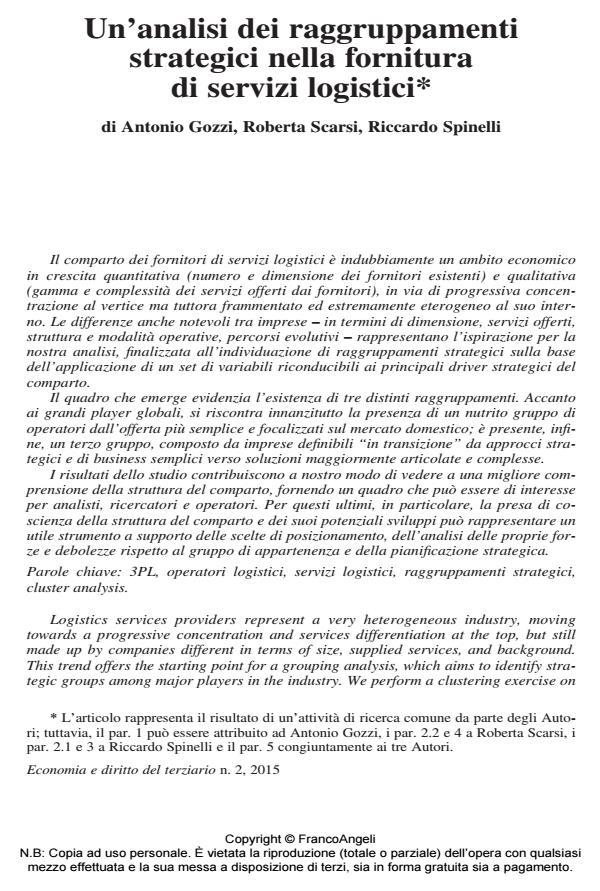Un’analisi dei raggruppamenti strategici nella fornitura di servizi logistici
Titolo Rivista ECONOMIA E DIRITTO DEL TERZIARIO
Autori/Curatori Antonio Gozzi, Roberta Scarsi, Riccardo Spinelli
Anno di pubblicazione 2015 Fascicolo 2015/2
Lingua Italiano Numero pagine 27 P. 231-257 Dimensione file 120 KB
DOI 10.3280/ED2015-002001
Il DOI è il codice a barre della proprietà intellettuale: per saperne di più
clicca qui
Qui sotto puoi vedere in anteprima la prima pagina di questo articolo.
Se questo articolo ti interessa, lo puoi acquistare (e scaricare in formato pdf) seguendo le facili indicazioni per acquistare il download credit. Acquista Download Credits per scaricare questo Articolo in formato PDF

FrancoAngeli è membro della Publishers International Linking Association, Inc (PILA)associazione indipendente e non profit per facilitare (attraverso i servizi tecnologici implementati da CrossRef.org) l’accesso degli studiosi ai contenuti digitali nelle pubblicazioni professionali e scientifiche
Il comparto dei fornitori di servizi logistici è indubbiamente un ambito economico in crescita quantitativa (numero e dimensione dei fornitori esistenti) e qualitativa (gamma e complessità dei servizi offerti dai fornitori), in via di progressiva concentrazione al vertice ma tuttora frammentato ed estremamente eterogeneo al suo interno. Le differenze anche notevoli tra imprese - in termini di dimensione, servizi offerti, struttura e modalità operative, percorsi evolutivi - rappresentano l’ispirazione per la nostra analisi, finalizzata all’individuazione di raggruppamenti strategici sulla base dell’applicazione di un set di variabili riconducibili ai principali driver strategici del comparto. Il quadro che emerge evidenzia l’esistenza di tre distinti raggruppamenti. Accanto ai grandi player globali, si riscontra innanzitutto la presenza di un nutrito gruppo di operatori dall’offerta più semplice e focalizzati sul mercato domestico; è presente, infine, un terzo gruppo, composto da imprese definibili "in transizione" da approcci strategici e di business semplici verso soluzioni maggiormente articolate e complesse. I risultati dello studio contribuiscono a nostro modo di vedere a una migliore comprensione della struttura del comparto, fornendo un quadro che può essere di interesse per analisti, ricercatori e operatori. Per questi ultimi, in particolare, la presa di coscienza della struttura del comparto e dei suoi potenziali sviluppi può rappresentare un utile strumento a supporto delle scelte di posizionamento, dell’analisi delle proprie forze e debolezze rispetto al gruppo di appartenenza e della pianificazione strategica.
Parole chiave:3PL, operatori logistici, servizi logistici, raggruppamenti strategici, cluster analysis.
Antonio Gozzi, Roberta Scarsi, Riccardo Spinelli, Un’analisi dei raggruppamenti strategici nella fornitura di servizi logistici in "ECONOMIA E DIRITTO DEL TERZIARIO " 2/2015, pp 231-257, DOI: 10.3280/ED2015-002001